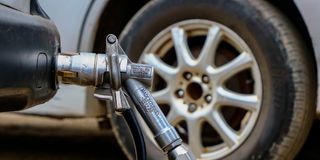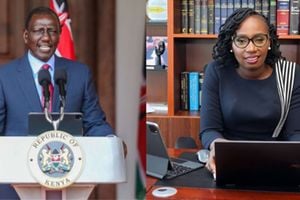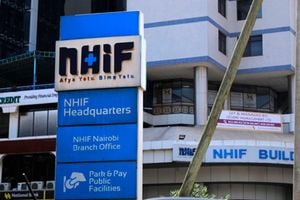Cost of living: Our LPG-run vehicles are saving us half in fuel costs

An LPG nozzle fuels a vehicle at a fueling station in Umoja 2, Nairobi on August 17, 2023, amid the tough economic times, motorists are modifying their vehicles to use LPG.
Until three months ago, Raphael Muigai was exclusively fuelling his van with petrol. The Nissan NV200 model, which he acquired three years ago, consumed about Sh5,000 or more a day whenever he was running errands. All that while, he did not know that there existed an option that would be somewhat cheaper.
But then, during a chat with a friend who is a matatu driver, he discovered that petrol-run engines can be modified to use Liquefied Petroleum Gas (LPG) or simply, LP gas.
The fuel gas, which contains a flammable mixture of hydrocarbon gases, specifically propane, propylene, butylene, isobutane, and n-butane, is used in heating appliances, cooking equipment, and vehicles, but it is increasingly being used as an aerosol propellant and a refrigerant, replacing chlorofluorocarbons in an effort to reduce damage to the ozone layer. When specifically used as a vehicle fuel, it is often referred to as autogas or even just as gas.
The friend, Mr Muigai narrates, convinced him to consider modifying his car to accommodate the two fuels.
An electrical technician by profession, Muigai says he uses his van for commercial purposes. As a technician, his work involves maintaining and repairing appliances for clients which sometimes involves picking up the goods and delivering them back to the owner. This involved a lot of driving to and fro the clients’ places of work.
“It is just the beginning and I’m loving it,” he says and adds, “I regret not knowing about this option earlier.”
When he made the decision to modify this vehicle, fuel prices were skyrocketing. The government had dropped the fuel subsidy which saw the country witness a sharp rise in the pump prices.
The price of a litre of petrol in September, as was in August, remains unchanged and continues to retail at Sh194.68. The LPG retails at Sh100 less.
“The distance that both covers is the same. Yet a litre of LP gas goes for Sh92,” he says.
This means that for a distance that would have cost him Sh3,000, he now uses Sh1,500, he explains.

An LPG nozzle at a fueling station in Umoja 2, Nairobi on August 17, 2023. Amid the tough economic times, motorists are modifying their vehicles to use LPG.
Sharing the same sentiments as Muigai was Simon Warutere, a matatu driver plying Outering Road. The Saturday Nation caught up with him at the autogas fuelling station in Nairobi’s Umoja 2 estate.
“Before I converted my vehicle to accommodate the two fuels, I would literally take nothing home at the end of the day. The profits were so marginal that I was even contemplating quitting this job,” he recounts.
After the modification, he says, he has witnessed an upward trajectory in profits. A litre of the LPG takes him for about 11 kilometres. He ventured into using the gas fuel two years ago. The modification saw his Suzuki van fitted with a 34-litre circular gas tank at the back.
“It cost me zero shillings to modify my car. I approached the autogas firm and it fitted my car with everything for free. As a businessman, there’s no better incentive to modification than knowing that you won’t incur any expenditures in doing the modification,” Mr Warutere says, adding that several months later, the car is still operating at optimum “and making maximum profits.”
But even with the modification, the car must still have a few litres of petrol that is initially used during the ignition of the engine before the car automatically changes to autogas. This happens automatically unless the driver switches off the LP gas usage.
During the combustion, the liquid LPG is injected directly into the combustion chamber.
Mr Warutere however decries that since the idea of LPG for motor vehicles is still novel in Kenya, not many have invested in it. As such, he has to drive all through to Eastlands to fuel.
“If it were near, I wouldn’t have to drive all this way to refill my tank,” he says.
At the time when Mr Isaac Muchesia, an Uber driver bought a Nissan Note, the autogas company was still piloting, he says. The firm was convincing drivers to consider modifying their cars to use LP gas. He was among the lucky few to get a Sh2,000 “inconvenience fee” for the two days that the firm was undertaking the conversion of his car. The gas tank was placed under the trunk of his vehicle.
“The gas was initially retailing at Sh98. It is now retailing at Sh92,” he says.
“This basically means that I’m taking home more money as compared to my counterparts in the Uber business who are still using petrol engines.”
He adds, “Since I switched to using LPG the profits are great. Given that the times are tough, this is a coping mechanism. I save half the cost of the fuel.”





